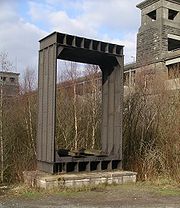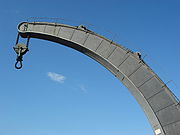
Box girder
Encyclopedia


Girder
A girder is a support beam used in construction. Girders often have an I-beam cross section for strength, but may also have a box shape, Z shape or other forms. Girder is the term used to denote the main horizontal support of a structure which supports smaller beams...
that forms an enclosed tube with multiple walls, rather than an
I-beam
-beams, also known as H-beams, W-beams , rolled steel joist , or double-T are beams with an - or H-shaped cross-section. The horizontal elements of the "" are flanges, while the vertical element is the web...
or H-beam. Originally constructed of rivet
Rivet
A rivet is a permanent mechanical fastener. Before being installed a rivet consists of a smooth cylindrical shaft with a head on one end. The end opposite the head is called the buck-tail. On installation the rivet is placed in a punched or pre-drilled hole, and the tail is upset, or bucked A rivet...
ed wrought iron
Wrought iron
thumb|The [[Eiffel tower]] is constructed from [[puddle iron]], a form of wrought ironWrought iron is an iron alloy with a very low carbon...
, they are now found in rolled or welded steel, aluminium extrusion
Extrusion
Extrusion is a process used to create objects of a fixed cross-sectional profile. A material is pushed or drawn through a die of the desired cross-section...
s or pre-stressed concrete
Reinforced concrete
Reinforced concrete is concrete in which reinforcement bars , reinforcement grids, plates or fibers have been incorporated to strengthen the concrete in tension. It was invented by French gardener Joseph Monier in 1849 and patented in 1867. The term Ferro Concrete refers only to concrete that is...
.
Compared to an -beam
I-beam
-beams, also known as H-beams, W-beams , rolled steel joist , or double-T are beams with an - or H-shaped cross-section. The horizontal elements of the "" are flanges, while the vertical element is the web...
, the advantage of a box girder is that it better resists torsion
Torsion (mechanics)
In solid mechanics, torsion is the twisting of an object due to an applied torque. In sections perpendicular to the torque axis, the resultant shear stress in this section is perpendicular to the radius....
. Having multiple vertical webs, it can also carry more load than an I beam of equal height (although it will use more material than a taller I beam of equivalent capacity).
The distinction in naming between a box girder and a tubular girder is imprecise. Generally the term box girder is used, especially if it is rectangular in section. Where the girder carries its "content" inside the box, such as the Britannia Bridge
Britannia Bridge
Britannia Bridge is a bridge across the Menai Strait between the island of Anglesey and the mainland of Wales. It was originally designed and built by Robert Stephenson as a tubular bridge of wrought iron rectangular box-section spans for carrying rail traffic...
, it is termed a tubular girder. Tubular girder is also used if the girder is round or oval in cross-section, such as the Royal Albert Bridge
Royal Albert Bridge
The Royal Albert Bridge is a railway bridge that spans the River Tamar in the United Kingdom between Plymouth, on the Devon bank, and Saltash on the Cornish bank. Its unique design consists of two lenticular iron trusses above the water, with conventional plate-girder approach spans. This gives...
.
Where a large box girder contains more than two walls, i.e. with multiple boxes, it is referred to as a cellular girder.
Development of the box girder
The theoretical basis of the box girder was largely the work of the engineer Sir William FairbairnWilliam Fairbairn
Sir William Fairbairn, 1st Baronet was a Scottish civil engineer, structural engineer and shipbuilder.-Early career:...
, with the aid of the mathematician Eaton Hodgkinson
Eaton Hodgkinson
Eaton A. Hodgkinson was an English engineer, a pioneer of the application of mathematics to problems of structural design.-Early life:...
, around 1830. They sought an optimal design for the most efficient design of beam in the new material of riveted wrought iron plates.
Cellular construction
Most girders are statically loaded such that one web is in compression, the other in tension. Fairbairn's original craneFairbairn steam crane
The Fairbairn steam crane is a type of harbourside crane of an 'improved design', patented in 1850 by Sir William Fairbairn. There is one surviving example in Bristol Docks, England.-Innovative design:...
s used a cellular construction for the compression face for their jib, so as to resist buckling. This jib was curved, tapered and formed of riveted wrought iron plates. Three cells were formed inside the concave (lower) face of this girder, again of riveted plates.
Where a tubular girder is used as a bridge span (i.e. loaded in the centre rather than at one end, like a crane) the compressive force is in the top web of the girder and so the cells are placed at the top. Dynamic forces (moving loads, wind) may also require both faces to be cellular, as may be seen in the Britannia Bridge section.
In some ways this isn't a "cellular girder" as such (compared to a spaceframe or geodesic construction) as the cells don't share loads from the entire girder, but merely act to stiffen one plate in isolation. Design of such complex integrated structures requires mathematical modelling techniques in advance of Fairbairn's day.
Box girders in bridges
Fairbairn's theoretical girder appeared at just the right time for the increasing demand for long railway bridges. Robert StephensonRobert Stephenson
Robert Stephenson FRS was an English civil engineer. He was the only son of George Stephenson, the famed locomotive builder and railway engineer; many of the achievements popularly credited to his father were actually the joint efforts of father and son.-Early life :He was born on the 16th of...
engaged both him and Hodgkinson as consultants to assist with his Britannia
Britannia Bridge
Britannia Bridge is a bridge across the Menai Strait between the island of Anglesey and the mainland of Wales. It was originally designed and built by Robert Stephenson as a tubular bridge of wrought iron rectangular box-section spans for carrying rail traffic...
and Conwy
Conwy Railway Bridge
Conwy railway bridge carries the North Wales coast railway line across the River Conwy between Llandudno Junction and the town of Conwy. The wrought iron tubular bridge was built by Robert Stephenson to a design by William Fairbairn, and is similar in construction to Stephenson's other famous...
bridges, both of which contained the railway track within a large tubular girder. Shortly afterwards Brunel
Isambard Kingdom Brunel
Isambard Kingdom Brunel, FRS , was a British civil engineer who built bridges and dockyards including the construction of the first major British railway, the Great Western Railway; a series of steamships, including the first propeller-driven transatlantic steamship; and numerous important bridges...
also chose to use a pair of small diameter round girders as part of a larger truss
Truss
In architecture and structural engineering, a truss is a structure comprising one or more triangular units constructed with straight members whose ends are connected at joints referred to as nodes. External forces and reactions to those forces are considered to act only at the nodes and result in...
at Chepstow. The Coronado Bay Bridge has the tallest box girder.
Safety concerns over box girder bridges
In the early 1970s, a number of box girder bridges collapsed during construction: the Cleddau BridgeCleddau Bridge
The Cleddau Bridge is a toll bridge on the A477 road that spans the River Cleddau between Neyland and Pembroke Dock, Wales. It was originally called the Milford Haven Bridge, Due to errors in the box girder design it collapsed during construction in 1970 and did not become operational until...
in Wales, West Gate Bridge
West Gate Bridge
The West Gate Bridge is a steel box girder cable-stayed bridge in Melbourne, Victoria, Australia. It spans the Yarra River, just north of its mouth into Port Phillip, and is a vital link between the inner city and Melbourne's western suburbs with the industrial suburbs in the west and with the city...
in Australia and the Koblenz Bridge in Germany. These led to extensive studies of the safety of box girders and serious concern over their continued use. This was also an early use of computer modeling and a spur to the development of finite element analysis in civil engineering
Civil engineering
Civil engineering is a professional engineering discipline that deals with the design, construction, and maintenance of the physical and naturally built environment, including works like roads, bridges, canals, dams, and buildings...
.
Bridges
- Tubular bridgeTubular bridgeA tubular bridge is a bridge built as a rigid box girder section within which the traffic is carried. Famous examples include the original Britannia Bridge over the Menai Strait and the Conwy railway bridge over the River Conwy, designed and tested by William Fairbairn and built by Robert...
s- Britannia BridgeBritannia BridgeBritannia Bridge is a bridge across the Menai Strait between the island of Anglesey and the mainland of Wales. It was originally designed and built by Robert Stephenson as a tubular bridge of wrought iron rectangular box-section spans for carrying rail traffic...
- Conwy Railway BridgeConwy Railway BridgeConwy railway bridge carries the North Wales coast railway line across the River Conwy between Llandudno Junction and the town of Conwy. The wrought iron tubular bridge was built by Robert Stephenson to a design by William Fairbairn, and is similar in construction to Stephenson's other famous...
- Britannia Bridge
- Box girder bridgeBox girder bridgeA box girder bridge is a bridge in which the main beams comprise girders in the shape of a hollow box. The box girder normally comprises either prestressed concrete, structural steel, or a composite of steel and reinforced concrete. The box is typically rectangular or trapezoidal in cross-section...
s- Cleddau BridgeCleddau BridgeThe Cleddau Bridge is a toll bridge on the A477 road that spans the River Cleddau between Neyland and Pembroke Dock, Wales. It was originally called the Milford Haven Bridge, Due to errors in the box girder design it collapsed during construction in 1970 and did not become operational until...
- West Gate BridgeWest Gate BridgeThe West Gate Bridge is a steel box girder cable-stayed bridge in Melbourne, Victoria, Australia. It spans the Yarra River, just north of its mouth into Port Phillip, and is a vital link between the inner city and Melbourne's western suburbs with the industrial suburbs in the west and with the city...
- Koblenz Bridge
- Gateway Bridge, BrisbaneBrisbaneBrisbane is the capital and most populous city in the Australian state of Queensland and the third most populous city in Australia. Brisbane's metropolitan area has a population of over 2 million, and the South East Queensland urban conurbation, centred around Brisbane, encompasses a population of...
, QueenslandQueenslandQueensland is a state of Australia, occupying the north-eastern section of the mainland continent. It is bordered by the Northern Territory, South Australia and New South Wales to the west, south-west and south respectively. To the east, Queensland is bordered by the Coral Sea and Pacific Ocean...
, AustraliaAustraliaAustralia , officially the Commonwealth of Australia, is a country in the Southern Hemisphere comprising the mainland of the Australian continent, the island of Tasmania, and numerous smaller islands in the Indian and Pacific Oceans. It is the world's sixth-largest country by total area...
- Cleddau Bridge

